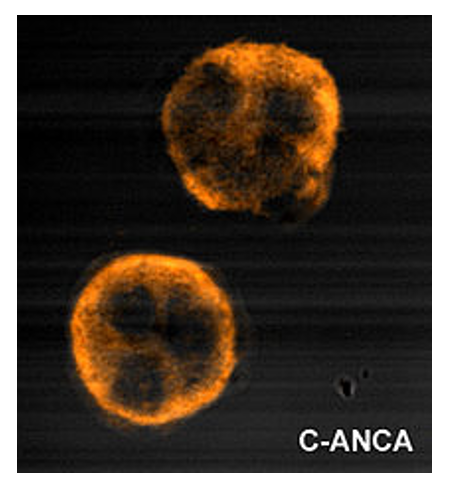Playlist
Show Playlist
Hide Playlist
Granulomatosis with Polyangiitis, Churg-Strauss Syndrome and Immunoglobulin G4-related Disease
-
Slides Vasculitis Mitchell.pdf
-
Reference List Pathology.pdf
-
Download Lecture Overview
00:01 Depending again where you are getting the immune complexes or the antibodies accumulating, you can have bowel pain and bleeding. 00:09 You can have muscle pain, you can have weakness. 00:12 And there's cutaneous purpura which has been demonstrated on the image on the right. 00:18 Granulomatosis with polyangiitis, which is a variant on this anca theme, occurs more frequently in men, peak incidence in the middle years. 00:28 Again, the etiology is not understood. 00:32 But we know in this particular case, we are getting a greater activation of T cells and macrophages, it's not just neutrophil activation. 00:43 And there are kind of three general presentations, a necrotizing granulomas and necrotizing granulomatous vasculitis, or focal necrotizing vasculitis, all of these things can occur. 00:56 And the particular variations on a theme, why they have variation is not clear. 01:04 We do know that there's a T cell mediated hypersensitivity response, and it's to environmental antigens, or to other microbial are to microbial infection. 01:15 So the classic features of Granulomatosis with polyangiitis, because of the way that the antigens are presumably getting in either inhaled or say pulmonary infectious is that more commonly this entity is associated with pneumonitis and can have cavitary infiltrates, we can get destruction of the lung parenchyma. 01:35 That's the majority. 01:37 They've also have a chronic sinusitis. 01:39 So again, the inflammation that's driving the vasculitis tends to be in the nasal and pulmonary passages. 01:50 You get mucosal ulcerations of nasopharynx. 01:53 And because again, you can also have these same anca lesions occurring in the kidney, you can have hypertension. 02:03 This is just showing you again in a schematic way, what I've just mentioned. 02:07 And so, again, more commonly we're going to see sinusitis, mucosal alterations of the nasopharynx and pneumonitis. 02:15 The lesions with polyangiitis are a vascular intimal hyperplasia a vasculitis with granulomas, nothing too specific about that, but it tends to involve the smaller vessels. 02:27 The recommended therapy for arthritis includes steroids with either rituximab or cyclophosphamide Rituximab is an anti-CD20 monoclonal antibody that will cause B lymphocyte killing. 02:39 That intern leads to reduced antibody responses. 02:42 Cyclophosphamide on the other hand is an alkylating immunosuppressant agent Longer term maintenance therapy will involve rituximab or other immunosuppression. 02:52 Finally, in the same category of ANCA associated vasculitis, Churg-Strauss syndrome is the third. 03:00 The etiology like the other two unknown. 03:03 The epidemiology is that it's often associated with a greater eosinophilic activation. 03:08 So you're going to get asthma, allergic rhinitis, lung infiltrates, and peripheral hypereosinophilia. 03:14 Signs and symptoms of Churg-Strauss. 03:16 Again, because of the hypereosinophilia is that we tend patients tend to have asthma attacks, they have an allergic rhinitis, they have the same cutaneous manifestations as the other so a palpable purpura, you get a mononeuritis multiplex, you can get involvement of the nerves although less common, and you can get inflammation of other structures such as the pericardium. 03:39 In about 60% of patients for unclear reasons, you can get a cardiomyopathy, some of this may be driven by cytokines, some of this may be driven by vasculitis involving the vessels of the heart. 03:50 And then gastrointestinal involvement will manifest with bleeding. 03:56 One last category of vascular injury vasculitis that we should talk about, is immunoglobulin G4, IgG4-related disease. 04:08 This is an entity that's only been recognized in perhaps the last decade or so. 04:12 It's a disorder that's characterized by high plasma levels of IgG4 so a particular isotype of immunoglobulin G. 04:20 And there's an associated tissue fibrosis that occurs frequently with IgG4-expressing plasma cells. 04:27 So that's the characteristic histologic appearance fibrosis with a lot of IgG4 plasma cells. 04:35 Interestingly, depending on the disease, it can affect just the pancreas or just the biliary system or just the salivary glands or just the aorta, or just pick your structure. 04:46 So we can affect any variety of things. 04:49 The commonality is the fibrosis, and the commonality is the association with IgG4. 04:56 So the clinical presentation depends on what vessel or what structure has been attacked. 05:01 And when we're talking about vasculitis, it's going to tend to be the aorta, and the periaortic structures. 05:09 In some cases, the damage that's elicited by the inflammatory infiltrate is such that it weakens the wall sufficiently to cause aneurysm formation. 05:21 The mainstay of therapy like most inflammatory vasculitis is steroid therapy. 05:27 And with that we've concluded a rather broad look at the various vasculitis. 05:34 And hopefully, you won't ever encounter one because they can be quite devastating in your patients, but it's important that you recognize them because they want you to recognize them on the boards.
About the Lecture
The lecture Granulomatosis with Polyangiitis, Churg-Strauss Syndrome and Immunoglobulin G4-related Disease by Richard Mitchell, MD, PhD is from the course Vasculitis.
Included Quiz Questions
What is the most common sign or symptom of granulomatosis with polyangiitis?
- Pneumonitis
- Joint pain
- Hematuria
- Headaches
- Vesicular rash
What histopathologic finding is associated with IgG4-related disease?
- Fibrosis
- Hypertrophy
- Aplasia
- Hyperplasia
- Atrophy
What is the initial treatment for granulomatosis with polyangiitis?
- Steroids and rituximab
- Steroids and etanercept
- Steroids alone
- Rituximab alone
- Etanercept alone
Customer reviews
5,0 of 5 stars
| 5 Stars |
|
1 |
| 4 Stars |
|
0 |
| 3 Stars |
|
0 |
| 2 Stars |
|
0 |
| 1 Star |
|
0 |
very clear explanation to help delineate the differences between these diseases/syndromes




